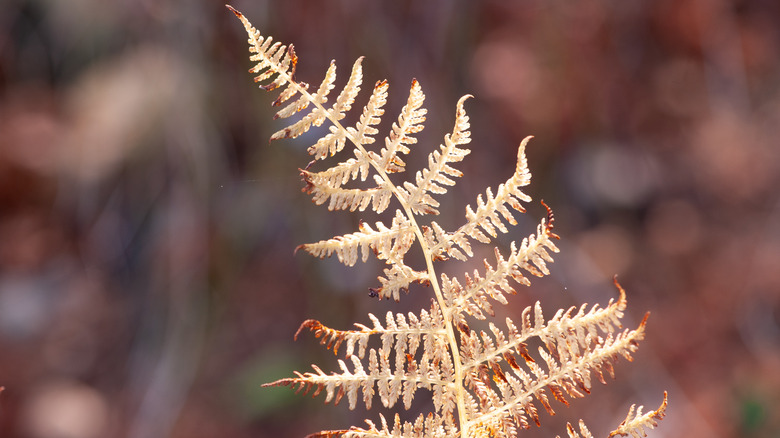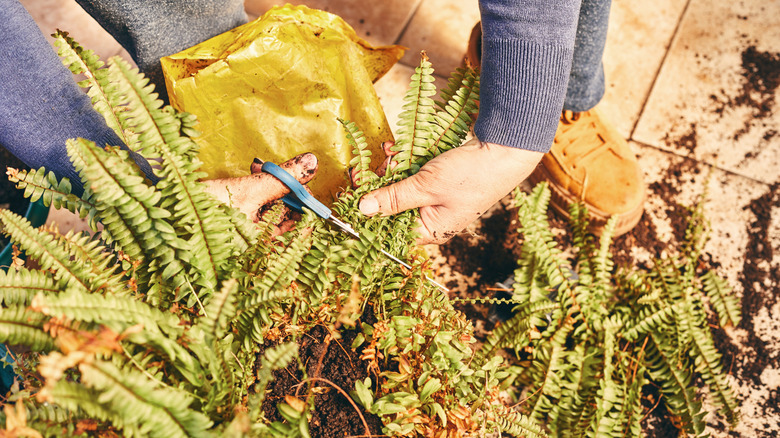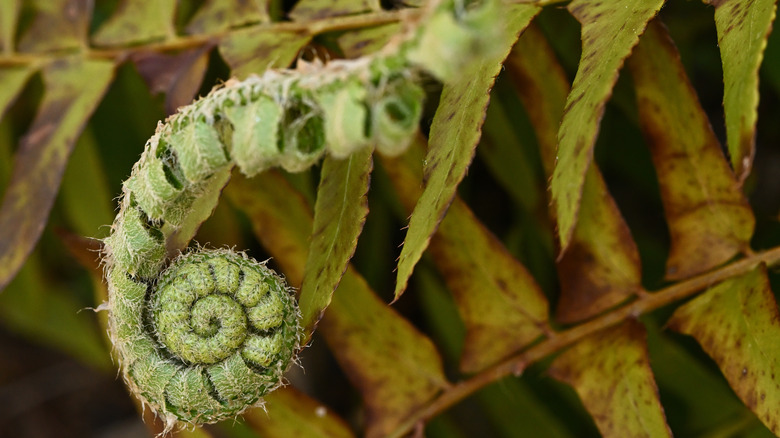Should You Cut Back Ferns Now Or Wait Until Spring? Here's What's Better For Their Health
Whether you should be pruning plants in the fall or spring is an eternal puzzle for gardeners, and ferns, with a wide variety of species that are hardy to the outdoor elements, don't make it easy to solve. When you're deciding whether to cut back your ferns in the fall, the type of fern in question matters. Consider whether the ferns are deciduous, evergreen, or wintergreen, and what the local climate will have in store. In fall, cut back only deciduous ferns that are showing signs like yellowing leaves. Evergreen, semi-evergreen, and wintergreen ferns don't need a trim until the end of winter or beginning of spring. As an added caution, be sparing about any cuts you make to types of ferns that grow slowly, whether that's due to the cultivar or how they respond to environmental conditions.
When the time comes to cut ferns back, you'll need clean shears or pruners, depending on the size of your plant. Cut off the individual fronds from their bases, whether you're pruning off dead leaves for deciduous ferns or clearing out old growth on other varieties. But remember that what's healthy for one type of fern won't be useful for another. Deciduous ferns shed their fronds rather than sticking it out for the winter. Cutting them back won't keep them from soaking up nutrients from the sun since they naturally enter a dormant state. For other types that don't shed foliage in the fall, though, waiting until late winter or the spring is important so they can photosynthesize. Evergreen and semi-evergreen ferns keep their fronds (to varying degrees) through the winter. Wintergreen ferns are rarer but can be confused for evergreens. Their foliage comes out in the colder months and they are dormant in the summertime.
Cut back yellowing deciduous ferns in the fall
If you're growing a deciduous fern like maidenhair fern (Adiantum pedatum), royal fern (Osmunda spectabilis), or river fern (Thelypteris kunthii), cut the plant back in the fall if its leaves are yellowing or turning brown. This pruning task can help hold off the growth of fungi and diseases while making it easier for new growth to come in after the winter. Most of the time, the decaying fronds will be at the bottom and around the edges of the plant. If all the leaves look healthy, though, it's okay to skip cutting them back and apply a layer of mulch while letting the leaves naturally wither, especially on ferns whose fronds are thin.
When you cut back deciduous ferns that have shown you they need a fall haircut, start by lopping off the dead and discolored fronds using your shears. For an efficient pruning, you can wait until you see many dead leaves and cut them all off quickly. Place the cutters close to the ground and snip off the base of the leaves that need to be discarded, taking the plant down to the soil level. If the fern looks like it has become overly thick, take this opportunity to thin out some of the green fronds, which will improve the airflow around these leaves.
Wait until spring to cut back evergreen ferns
For the health of evergreen ferns like the Christmas fern (Polystichum acrostichoides) and autumn fern (Dryopteris erythrosora), don't cut them back in the fall. Because they're putting out foliage through the fall and winter, they need every intact frond to gather up energy through photosynthesis and are plants you should be pruning in spring. That being said, you can trim off damaged or browning leaves throughout the course of the winter. In addition to keeping an eye on damaged leaves to trim, mulching is a step you can take to ensure ferns will flourish in cold weather, since it helps keep the soil around their roots warm and moist. Also, don't be alarmed if your evergreen ferns to get a bit droopy during the cold-weather seasons, which can be normal.
Cutting back evergreen ferns in the early spring is important so that damaged fronds are removed and there's room for young fronds, known as fiddleheads, to emerge. Do this after the coldest weather is over to give this new life its best fighting chance. To avoid old leaves getting tangled, the best course of action is to cut them back before any new growth develops, but if you see little curled fronds, those are the baby fiddleheads you'll want to be careful not to cut off with anything that's old or damaged from the winter. Otherwise, The process is similar to cutting back deciduous ferns in the fall. When you're done, don't fertilize your evergreen ferns right away, but wait until noticeable new growth has come in.


